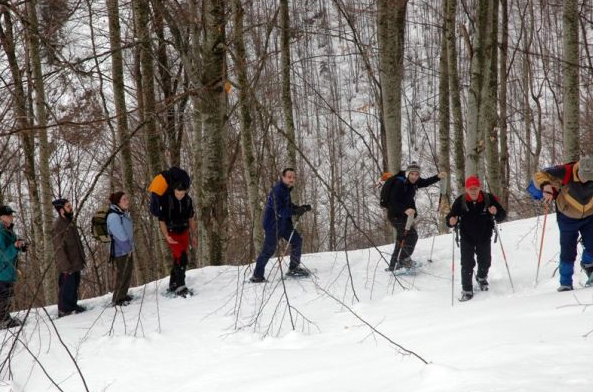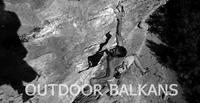
The Rugova Valley - photo Rugova Experience
Mustafa provides the accommodation, Agim is the guide. Both strongly believe that the Rugova Valley has all the right credentials to soon become an exceptional destination in Kosovo for outdoor activity tourism
The sun is setting over the Rugova Valley's peaks as we sit under the pergola outside the house of Mustafa Nikci, one of the Valley's inhabitants and our host. Next to us is Agim Hagku, aka “Yole”, our guide in the valley.
Mustafa is providing the accommodation, whilst Agim is our guide for the valley paths. Agim was one of the first persons to take visitors into the valley and develop tourism within the area. The tourist packages foresee meals and overnight stays in the valley's houses: the dinner was superb with nearly all being home made with milk, cheese, yoghurt and fruit and vegetables from the vegetable patch.
The house, both extremely clean and comfortable, is one of many houses which make up an accommodation network run by Rugova Experience, providing strategic accommodation for those either wanting to go trekking in the Rugova Valley or simply wanting to spend a relaxing weekend in the mountains.
Mustafa Nikci lives in the Rugova Valley from April to October, keeping livestock. The rest of the year he passes it in the city of Peja/Peć. With him are his wife, daughter and other family members who have come to pass the weekend in the mountains. The house is about 20kms from Peja/Peć. On leaving the main asphalt road we took a scrambly rough road which clambered up a lot of kms to reach Mustafa's house, at an altitude of about 1200m.
What is The Rugova Valley's History?
Mustafa: There are around 13 villages in the valley, with each village having about 30-40 houses inhabited by their owners, about 1.000 people, mostly during the summer months. Before the war there were about 15-20 houses, lived in all year round. People mainly live off arable and livestock farming. In the past, life here was hard as the area lacked roads, facilities, factories and therefore jobs. During the recent conflict all the houses were burnt down and the people moved to the city. Now they've started to return, many non-governmental organisations have helped rebuild the houses and in the last 5-6 years there has been an increase in the number of people living in the Rugova Valley.
And the experience in tourism?
Agim: Out of all those who have worked on this valley, it was the “Seenet” program who started to organise meetings and set up proper fields in the valley. Then Fatos, one of the valley's inhabitants, suggested to work together with “Rugova Experience” and this new challenge was launched. ”Rugova Experience”, which was set up with the support of the Italian association “Tavolo Trentino con il Kosovo”, started to introduce the possibility for excursions into the valley, and gradually the inhabitants started to offer tourist accommodation in their houses. It all started from there. Slowly but surely this has become a mini boom, above all in the last two years: as soon as more accommodation became available, more tourists arrived and Mustafa has now opened up his home.
And during the winter months?
Agim: Mustafa comes here in April and leaves in October, it is very hard to stay in the winter months as we get up to one and a half metres' snowfall. There are only four villages which are lived in all year round, one of which is Boge, which is also a skiing resort and so stays open all year. Boge has a one and a half kilometre long ski lift and several houses to rent for winter weekends. There is also a small hotel which acts as a rehabilitation centre for those with respiratory and allergy complaints. There are also possibilities for alpine skiing and snow shoe walking so we can safely say it is also inviting in winter.
Where do your guests come from?
Mustafa:
Guests come from all over:they're English, Italians, Estonians, Swiss, Germans... They are sent here via Rugova Experience. They often come here for weekends, and in that case a typical programme includes a seven hour trek on Mount Hajla (2400m) after which they come back to sleep in this village and continue with a six hour trek the day after up Mount Stedim. Then they return here again and head down to the city of Peja/Peć at the end of the day. Mostly they are people who live in Pristina and work for various international organisations.
In other areas of the Rugova Valley there are tourist bungalows used by groups of Albanian tourists. This area is part of the tourist packages sold on behalf of the Albanian tourist agencies. These packages include five days at the sea in Albania and five days' trekking which pass through Kosovo and go on to Albania in the Valbona area. The area has gained from the fact that Albania is becoming an important tourist destination for all Europe.
What do you foresee for Rugova Valley's future? What else is needed?
Agim: Once there is an increase in the number of visitors, there will be a need to increase the accommodation and facilities in the valley. Rugova Experience is already considering to include another 5-6 villages in its offers, and to connect them with a network of paths going from one village to another. We are pleased with how tourism has taken off, though we need to think what we can add to it. We are already in need of other guides who are keen to do this job at professional standards, we will already need to work on this next year.
If we continue at this pace, with the network of footpaths founded towards Albania and Montenegro, which measures about 250 kms across the borders, we could set up a trek lasting for over ten days, and in this way it would be easier to keep people living in the villages. However we need to work more on this, we need to create paths, signpost them well, find rest points and accommodation and above all work on their marketing and promotion. There are all kinds of excursions from the very easy to the arduous. We ourselves feel that this could be a wonderful opportunity for anyone wishing to work on this area on a full time basis. Obviously, if and only there is someone who would want to do this.








